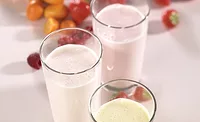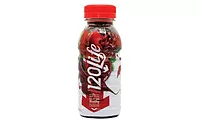Uptick in beverages fortified with vitamins and minerals
Enhanced waters offer new potential for fortification

In the “Lion King,” Mufasa tells his young son Simba about the “Circle of Life” and the importance of nature taking and giving back life to earth, and the connectedness of all living things. Fortifying with vitamins and minerals also fosters a “greater connection,” as these nutrients are helping to give beverages a competitive, nutritional edge.
While beverage companies have been formulating with vitamins and minerals for years, like vitamin D and vitamin C used in milks and juices, respectively, for decades, technological advancements in beverage formulations is impacting ready-to-drink (RTD) beverages, says Samantha Ford, director of business development at AIDP Inc., City of Industry, Calif.
“The change has been in areas such as technologies for improved absorption, addition of antioxidants and plant-based alternatives to synthetic or animal-derived ingredients,” Ford explains. “Although this doesn’t fall in the vitamin/mineral category, it’s worth mentioning the addition of prebiotic ingredients in RTD beverages is rapidly growing as digestive health solutions are seeing increased demand.”
Andy Ohmes, global director of high-intensity sweeteners at Minneapolis-based Cargill, points out that “simple hydration” is no longer enough as consumers seek out functional beverages. “Beverages fortified with vitamins and minerals are one way to deliver on that demand,” he says. “As Nielsen’s recent 2019 Health Care Survey found, nearly half (47 percent) of consumers say the presence of vitamins and minerals are important attributes in their purchase decision.
“At the same time, we know consumers are paying closer attention to sugar content, and that extends to the better-for-you drink space. Many of the fortified drinks — while laden with nutrients — are also packed with sugar,” he continues. “Fortunately, a growing array of alternative sweetener options offer formulators a way to create fortified beverages that keep sugar in check, while still delivering a great-tasting beverage.”
Citing Chicago-based Mintel’s new product database, Emily Hallock, primary research manager at Chicago-based Glanbia Nutritionals, notes a 69 percent increase in new vitamin- and mineral-fortified beverages since November 2016.
“This number is especially interesting when you keep in mind [that] vitamin and mineral fortification is not a new concept,” she says. “Consumers are applying their demand for transparency, functionality and better-for-you ingredients to the beverage category.
“No longer is colored, flavored water that provides no additional benefit an acceptable option,” Hallock continues. “Manufacturers need to reformulate the beverages of yesteryear to fit consumers’ changing expectations of health and functionality.”
Nathan Pratt, nutrition scientist at Kerry Taste and Nutrition, Beloit, Wis., suggests that plant-based dairy alternatives are part of a trending category that aligns well with vitamin and mineral fortification. “Dairy milk is a key piece of nutrition around the world,” he says. “It is high in calcium, vitamin D (via fortification), potassium, vitamin A and vitamin B-12, so it is important for plant-based alternatives to dairy to be rich in vitamins and minerals, too.
“For example, 33 percent of the calcium intake in the U.S. population comes from dairy,” he continues. “Most people in the U.S. and Canada do not get enough of these nutrients already.”
Closer to nature
Beverage makers are addressing better-for-you, clean-label trends now more than ever and recognize that chosen ingredients also should be good-tasting, soluble and easily handled — all with high nutritional impact to meets specific health and label claims, experts note.
David O’Leary, commercial manager of Marigot Ltd., Cork, Ireland, points out that a manufacturer’s ability to apply the minerals or vitamins across various delivery systems is key to success.
“[T]here are so many options available — waters, juices, RTDs, ready-to-mix sachets, stick packs, smoothies, fermented drinks, non-alcoholic drinks, electrolyte beverages for replenishment/recovery, cold brews, etc.,” O’Leary says. “The ability to provide an ingredient offering which can meet with the specific requirements of consumers’ diets (vegetarian, vegan, paleo, etc.) is key and must be considered at the formulation stage when screening ingredients while delivering the marketing brief.”
While some beverage brands are seizing the upcoming 2020 Nutrition Facts Label update as the right time to optimize their beverage fortifications, Fullerton, Calif.-based Stauber Brand Manager Patrick Stano says its tough to determine the reasoning. “It is difficult to pinpoint the reason across the board, whether it be the U.S. Dietary Guidelines, overall desire for improved products, etc.,” he says.
More so than government-recommended guidelines, Holly McHugh, marketing associate at Niles, Ill.-based Imbibe, believes consumers are choosing products with vitamins and minerals based on what they believe is important for their well-being. “Easy access to information online and personalized health technologies like FitBit and at-home wellness tests have enabled consumers to perform their own research about dietary needs,” she says.
McHugh also believes that the proliferation of dairy-alternative milks have increased vitamin and mineral usage. “Brands often want their product to have similar nutrient values to dairy milk,” she explains. “This requires additional fortification in processed beverages, so some nutrients will degrade when exposed to high temperatures.”
The vitamin/mineral scene
To capitalize on consumers’ changing expectations, more beverage brands formulated with vitamins and minerals are hitting store shelves. Beverage-makers also have a rich arsenal of vitamins and minerals from which to choose, experts say.
These include B vitamins such as pyridoxine hydrochloride, niacinamide, cyanocobalamin along with vitamin C, trisodium and potassium citrates, vitamin A and vitamin D, Glanbia Nutritionals’ Hallock says, noting the explosive growth of these nutrients. For instance, B vitamins such as pyridoxine hydrochloride and niacinamide have seen increases in excess of 100 percent, while minerals such as sodium ascorbate and chromium picolinate have increased in use approximately 65 percent, she adds.
“Since November 2016, several of these vitamins have seen a significant change in usage in new beverage products,” Hallock says. “Beta carotene has seen an increase of 340 percent use as an ingredient in new products, cholecalciferol (vitamin D3) and riboflavin (vitamin B2) have both seen almost a 150 percent increase.”
When it comes to functional beverages, Hallock says she’s not surprised that B vitamins are surpassing expectations. “Consumers’ busy lifestyles have them reaching for beverage solutions that will help them stay active longer, and B vitamins support the body’s ability to convert food into energy and maintain healthy skin cells, brain cells and other body tissues,” she says.
AIDP’s Ford also touts the effectiveness of B and D vitamins: “The growth of B vitamins as an energy supplement has grown in the beverage space,” she says. “In addition, vitamin D has developed a strong consumer awareness and its importance is widely recognized. Finally, we are seeing a growing interest in vitamin K2 as a compliment to calcium-enriched products.”
She also notes that meal replacements and the huge growth of protein drinks, many of which are fortified with plant-based vitamins and minerals, are “filling the bill.”
“The same is trending across dairy-alternative drinks,” Ford says. “AIDP offers the only pure vegan vitamin D3, VegD3, which can be used as a one-to-one replacement to animal-based D3. Our enVantec technology is a gelatin-free encapsulation solution for fat soluble nutrients and ideal for beverage applications.”
Satisfying fortification needs
Because busy consumers desire on-the-go nutrition to fuel their active lives, new products containing vitamins and minerals are getting their “place in the sun.”
Stauber’s Stano pinpoints a growing number of enhanced or fortified waters, along with meal replacements, protein drinks, plant-based milk alternatives, juices and rehydration drinks, contain vitamins and minerals on their labels. “We expect more to follow,” he says.
Several national brands have released new products to help consumers “start the morning and power through the day,” Glanbia’s Hallock says. For example, Starbucks’ new Caffé Mocha Extra Strength Energy Coffee Beverage, which contains inositol, and other B vitamins, in addition to the caffeine, guarana, and ginseng, has seen “over $7.5 million in cumulative sales in the 34 weeks it’s been on the shelf,” she says.
She also points to the success of Talking Rain’s Sparkling Ice + Caffeine beverage, a flavored Strawberry Citrus with caffeine, antioxidants and vitamins, which is low in calories and free from sugar or juice.
Beverages that provide these “added benefits” while also keeping current consumer trends like low/no added sugar, no artificial colors or flavors, functional ingredients that benefit health are seeing widespread acceptance, Hallock notes.
Yet, protecting the efficacy of vitamins and mineral in final formulations can be challenging because it depends on a number of factors, notes Jing Zhou, business scientist of global plant-based proteins research and development for Ingredion, Westchester, Ill.
Vitamins are sensitive to pH, oxygen, moisture, light, heat or a combination of these conditions, while minerals are minimally influenced by heat, light, oxidizing agents or pH, Zhou explains.
“The efficacy of vitamins and minerals depends on the amount of fortification in the beverage and the consumption of the target vitamin or mineral in one’s regular diet,” he says. “If we think of this question in the sense of how to best preserve the nutritional quality of vitamins and minerals, then beverage-makers must be watchful of how the processing, packaging, and storage of beverages may impact the quantity and bioavailability of vitamins and minerals.”
Because many beverages include nutrients that have antioxidant functionality, Glen Taylor, senior formulation scientist manager at Glanbia Nutritionals, suggests including additional antioxidants such as mixed tocopherols to formulations to maximize nutrients’ functionality.
“Vitamin C is especially susceptible to rapid degradation depending on the physical characteristics of your beverage,” he says. “Some opportunities can be addressed by encapsulating nutrients. Vitamins and minerals do not usually enhance flavors, so taste can be an issue. When nutrients are suspended in a beverage, Glanbia offers insoluble encapsulations from recently acquired Watson (fats, waxes, cellulose derivatives, etc.) that are capable of masking bitter, acid or other off-flavors.”
On the horizon, Marigot’s O’Leary suggests further extension and widening of beverage categories is expected. “One area no doubt will be water fortification,” he says. “While looked at many years ago, the technology and ingredient range now offers new possibilities and we expect it will be revisited as a sector with so much potential.” BI
Looking for a reprint of this article?
From high-res PDFs to custom plaques, order your copy today!





